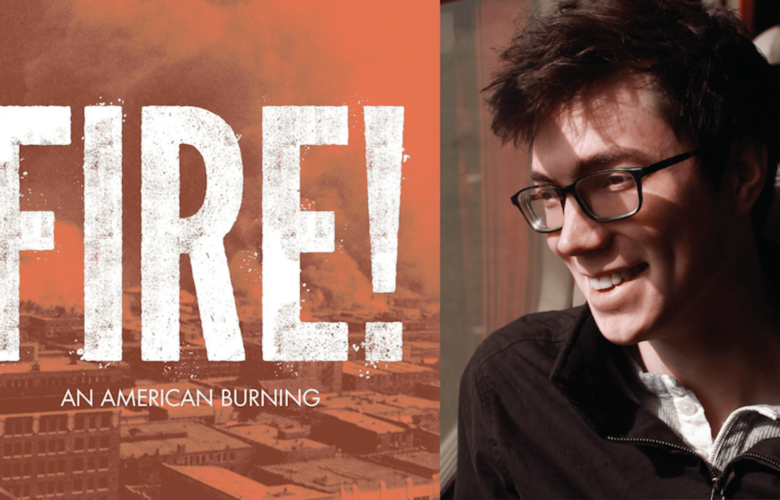In conversation with Ryan Schnurr, creator of podcast Fire!: An American Burning
December 4, 2023We had the opportunity to chat with Ryan Schnurr, host of the new podcast, Fire!: An American Burning, which takes a deep dive into the stories of twentieth and twenty-first…
We had the opportunity to chat with Ryan Schnurr, host of the new podcast, Fire!: An American Burning, which takes a deep dive into the stories of twentieth and twenty-first century industrial fires in American cities and their profound connection to contemporary climate crisis. It is produced by Belt Magazine and the episode on Whiting, Ind. was supported by a grant from Indiana Humanities.
How did you settle on the fires you covered, and how did researching these incidents inform how you view the climate crisis today?
Honestly, I just started with the ones that seemed most interesting to me. The ones I couldn’t get out of my mind. It’s not a comprehensive list, of course. But at some point I realized these five, strung together, began to connect the dots between industrialization and climate crisis in a way that felt useful—how the fires of industry began to subsume the world.
Why did you decide a podcast was the best platform for telling these stories?
Fire! is, at its heart, a storytelling project, so I wanted to lean into that long human tradition of sitting around telling each other stories (often, incidentally, gathered around a fire). Audio is a great way to incorporate that sort of depth and intimacy, particularly with interviews. It’s less abstract than text on a page. Plus, it seemed like a great way to reach public audiences right now.
What conversations do you hope to start about the environment and our relationship to it with this podcast?
I don’t know that I want to start a conversation so much as contribute to the ones that are already happening. I like that old William Carlos Williams line: “no ideas but in things.” It’s notoriously difficult to wrap our minds around big, abstract ideas (like climate crisis at a planetary scale). Metaphors help, and so do concrete events. So hopefully, by rooting the conversation in these specific fires and the metaphorical resonance of fire, we can get a little bit farther in those conversations.
How do you foresee the boundary collapse between industry and nature affecting the cultures of the places you covered in the podcast?
Well, I think the boundary was never there to begin with—industry is just a rearranging and re-constitution of the things we would traditionally consider to be nature. We told ourselves there was a boundary because that’s what you have to do to avoid thinking about how dangerous and volatile some of these rearrangements are. But I think these stories are all about how the fire of industrialization just keeps growing bigger and bigger, looking for more things to consume, and in the process creating what theorists call “new natures.” In other words, we don’t live in the same world we used to live in. We’re constantly shaping and changing it. That can be pretty depressing, particularly given some of the ways we’ve chosen to do this over the years. But I think it’s also empowering—if we can make the world more volatile and dangerous, we can also make it more nurturing and livable.
What other pieces of media would you recommend to people who are interested in learning more about what you talk about in Fire!, especially when it comes to Indiana?
I compiled a list of “sources and further reading” for each episode, which you can find on the episode pages on Belt Magazine’s site. For Indiana, you can’t go wrong reading anything Ava Tomasula y Garcia has written, particularly “What Indiana Dunes National Park and the Border Wall Have in Common” and “The Long Tail of Indiana’s Oil and Gas Boom.” I also like Jonathan Wlasiuk’s book Refining Nature, about Standard Oil. And the Whiting-Robertsdale Historical Society has some great resources on the refinery and community.
What throughlines have you found while interviewing the people featured in your podcast?
I think the biggest throughline in the episodes is how these industrial fires illuminate the complex cultural, political, economic, and ecological relationships in the industrial era. They are a key part of the ongoing creation and re-creation of the world, from minor river fires to massive wildfires, and it’s all more complicated and important than we can possibly imagine.
Was there anything that surprised you while you were creating the episodes?
What I like about research and reporting is that you’re constantly being surprised by something—a moment, a detail, a perspective. I tried to pack the episodes full of as many of these surprises as possible, and then bring the listener along with me to encounter them.
Fire! is a limited series. What’s next for you after it’s finished?
I’ve got a few projects kicking around, but nothing I’m quite ready to share—I’ll let you know when I am!
About Ryan
Ryan Schnurr is the author of In the Watershed and writer for hire covering climate, culture, infrastructure and more. He used to edit Belt Magazine (and still writes there sometimes). He is also the creator of the forthcoming podcast series Fire!, on industrial fires and climate crisis in American cities.
Ryan received his PhD and MA from Purdue University and the University of Illinois at Chicago, respectively, and is currently an assistant professor in the Department of Humanities and Communication at Trine University.
You can find the Fire!: An American Burning podcast on platforms like Spotify and Apple Podcasts.


